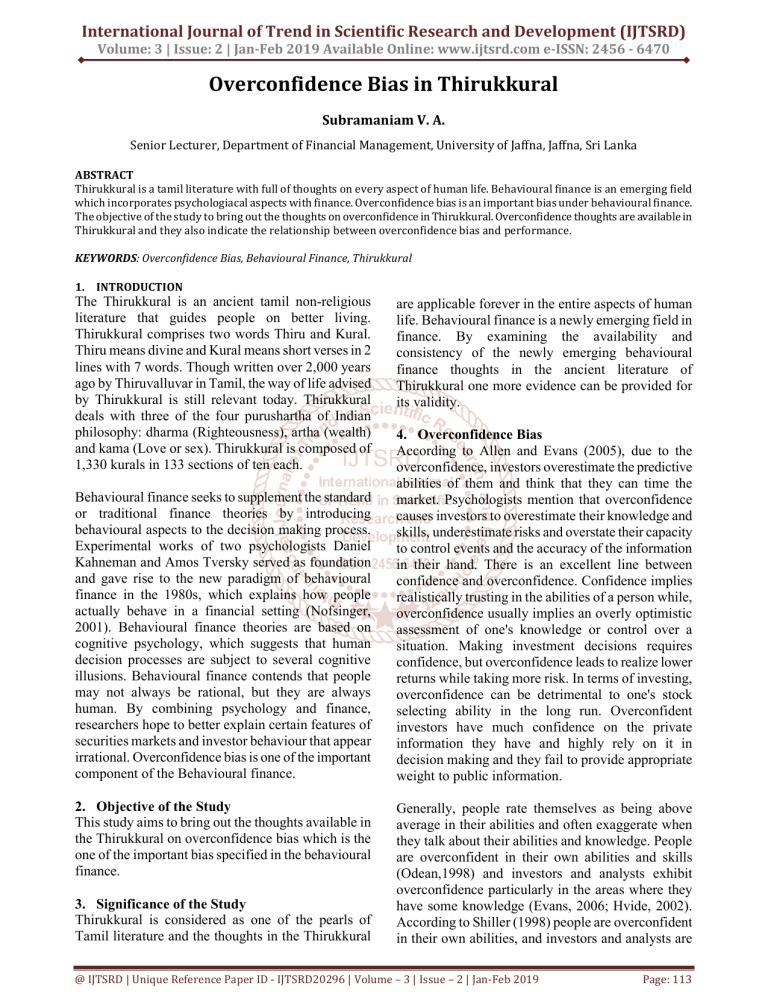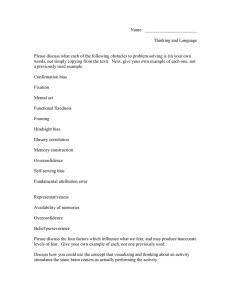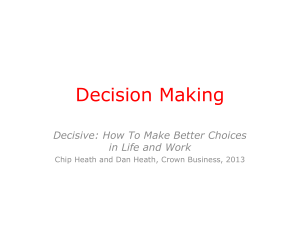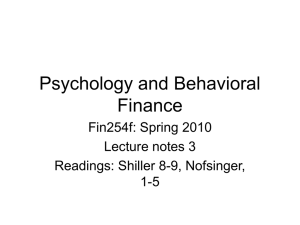Uploaded by
mail
Overconfidence Bias in Thirukkural: A Behavioral Finance Study

International Journal of Trend in Scientific Research and Development (IJTSRD) Volume: 3 | Issue: 2 | Jan-Feb 2019 Available Online: www.ijtsrd.com e-ISSN: 2456 - 6470 Overconfidence Bias in Thirukkural Subramaniam V. A. Senior Lecturer, Department of Financial Management, University of Jaffna, Jaffna, Sri Lanka ABSTRACT Thirukkural is a tamil literature with full of thoughts on every aspect of human life. Behavioural finance is an emerging field which incorporates psychologiacal aspects with finance. Overconfidence bias is an important bias under behavioural finance. The objective of the study to bring out the thoughts on overconfidence in Thirukkural. Overconfidence thoughts are available in Thirukkural and they also indicate the relationship between overconfidence bias and performance. KEYWORDS: Overconfidence Bias, Behavioural Finance, Thirukkural 1. INTRODUCTION The Thirukkural is an ancient tamil non-religious literature that guides people on better living. Thirukkural comprises two words Thiru and Kural. Thiru means divine and Kural means short verses in 2 lines with 7 words. Though written over 2,000 years ago by Thiruvalluvar in Tamil, the way of life advised by Thirukkural is still relevant today. Thirukkural deals with three of the four purushartha of Indian philosophy: dharma (Righteousness), artha (wealth) and kama (Love or sex). Thirukkural is composed of 1,330 kurals in 133 sections of ten each. Behavioural finance seeks to supplement the standard or traditional finance theories by introducing behavioural aspects to the decision making process. Experimental works of two psychologists Daniel Kahneman and Amos Tversky served as foundation and gave rise to the new paradigm of behavioural finance in the 1980s, which explains how people actually behave in a financial setting (Nofsinger, 2001). Behavioural finance theories are based on cognitive psychology, which suggests that human decision processes are subject to several cognitive illusions. Behavioural finance contends that people may not always be rational, but they are always human. By combining psychology and finance, researchers hope to better explain certain features of securities markets and investor behaviour that appear irrational. Overconfidence bias is one of the important component of the Behavioural finance. 2. Objective of the Study This study aims to bring out the thoughts available in the Thirukkural on overconfidence bias which is the one of the important bias specified in the behavioural finance. 3. Significance of the Study Thirukkural is considered as one of the pearls of Tamil literature and the thoughts in the Thirukkural are applicable forever in the entire aspects of human life. Behavioural finance is a newly emerging field in finance. By examining the availability and consistency of the newly emerging behavioural finance thoughts in the ancient literature of Thirukkural one more evidence can be provided for its validity. 4. Overconfidence Bias According to Allen and Evans (2005), due to the overconfidence, investors overestimate the predictive abilities of them and think that they can time the market. Psychologists mention that overconfidence causes investors to overestimate their knowledge and skills, underestimate risks and overstate their capacity to control events and the accuracy of the information in their hand. There is an excellent line between confidence and overconfidence. Confidence implies realistically trusting in the abilities of a person while, overconfidence usually implies an overly optimistic assessment of one's knowledge or control over a situation. Making investment decisions requires confidence, but overconfidence leads to realize lower returns while taking more risk. In terms of investing, overconfidence can be detrimental to one's stock selecting ability in the long run. Overconfident investors have much confidence on the private information they have and highly rely on it in decision making and they fail to provide appropriate weight to public information. Generally, people rate themselves as being above average in their abilities and often exaggerate when they talk about their abilities and knowledge. People are overconfident in their own abilities and skills (Odean,1998) and investors and analysts exhibit overconfidence particularly in the areas where they have some knowledge (Evans, 2006; Hvide, 2002). According to Shiller (1998) people are overconfident in their own abilities, and investors and analysts are @ IJTSRD | Unique Reference Paper ID - IJTSRD20296 | Volume – 3 | Issue – 2 | Jan-Feb 2019 Page: 113 International Journal of Trend in Scientific Research and Development (IJTSRD) @ www.ijtsrd.com eISSN: 2456-6470 particularly overconfident in areas where they have some knowledge. Overconfidence leads investors to overestimate their predictive skills and believe that they can time the market. Studies have shown that one side effect of investor overconfidence is excessive trading (Evans, 2006; Allen and Evans, 2005). According to Glaser and Weber (2007), there are three aspects of overconfidence, namely miscalibration, the better than average effect and illusion of control. The better than average effect means that people tend to believe that they have higher than average skills and illusion of control indicates that the tendency to believe that one's personal probability to success is higher than objective probability would warrant. Glaser and Weber (2007) stated that miscalibration leads to higher trading activities. Many authors mentioned that overconfidence results in excessive trading and holding risky assets (Evans, 2006; Allen and Evans, 2005; Barber and Odean, 2001). Overconfident Investors take higher level of risk, under react to new information and fail to diversify their investment. Finally, these lead to poor performance of their portfolio. Barber and Odean (2000) highlighted that higher level of trading was a result of overconfidence bias of investors which resulted in poor investment performance. Kim and Nofsinger, (2003) indicated that overconfident investors tend to sell their winners and holding their losers, which may lead to poor investment results. 5. Overconfidence Bias in Thiruukkural Thiruvalluvar elucidates about implications of overconfidence with excellent examples in the Kural 474, Kural 475 and Kural 476. AMAINTHAAN KOZHUGAAN ALAVARRIYAAN THANNAI VIYANTHAAN VIRAINTHU KEDUM (Kural 474) The Kural 474 states that he will quickly perish who, ignorant of his own resources, has an exaggerated opinion of himself and does not live in peace with his neighbours. The Kural 474 particularly indicates the effect of better than average effect which is the one of the important component of overconfidence bias. PEELIPEY SAAGAADUM ACCIRUM APPANDDAM CHAALA MIGUTTHUP PEYIN (Kural 475) The Kural 475 indicates that the axle tree of a bandy, loaded only with peacocks' feathers will break, if it be greatly overloaded. NUNIKKOMBAR ERRINAAR ATTHIRRANTHOOKKIN UYIRKKIRRUTHI AAGIVIDUM (Kural 476) The Kural 476 specifies that there will be an end to the life of him who, having climbed out to the end of a branch, ventures to go further. The results of the actions of an overconfident person indicated by the Thiruvalluvay is consistent with the findings of the Barber and Odean (2000), Kim and Nofsinger, (2003) and Evans (2006) which reveal a negative relationship between the overconfident bias and investment performance of investors. In addition, Thirukkural specifies the ways to avoid the overconfidence bias and to improve performance. VINAIVALIYUM THANVALIYUM MAATTAAN VALIYUM THUNAIVALIYUNTHOOKKICH CHEYAL (Kural 471) The Kural 471 states that let (one) weigh well the strength of the deed (he purposes to do), his own strength, the strength of his enemy, and the strength of the allies (of both), and then let him act. In addition, the negative impact of overconfidence bias on performance can be eliminated by obtaining the advices and services of the experts and consultants who have more access to more accurate public information. It is described in the Kural 462. THERINTHA INATTHODU TERNTHENNICHEYVAARKKU ARUMPORUL YAATHONRUM IL (Kural 462) The Kural 462 says there is nothing unachievable for those who have joined the company of experts in the field and who also have the capacity to consider the pros and cons of the action. Further the solution for the illusion of control aspect also is mentioned in the Kural 482. PARUVATHTHODOTTA OZHAGAL THIRUVINAITH THEERAAMAI AARKKUNG KAYIRRU (Kural 482) According to Kural 482 the right action at the right time, will act as the rope which will bind the unstable wealth and prevent it from going away. Conclusion Thirukkural deals with the entire aspect of human life and the thoughts indicated in the Thirukkural is applicable incessantly. This paper attempted to bring out the thoughts available in Thirukkural on overconfidence bias which is an important component @ IJTSRD | Unique Reference Paper ID - IJTSRD20296 | Volume – 3 | Issue – 2 | Jan-Feb 2019 Page: 114 International Journal of Trend in Scientific Research and Development (IJTSRD) @ www.ijtsrd.com eISSN: 2456-6470 in the behavioural finance. Behavioural finance is a newly emerging field in finance. However, various aspects of overconfidence bias were discussed in the Thirukkural and which are consistent with the findings of recent studies in the field of behavioural finance. It indicates the applicability and validity of the thoughts in the Thirukkural forever. REFERENCES [1] Alexander, G. J., Sharpe, W. F. and Bailey, J. V., 2012. Fundamentals of Investments 3rd edition. PHI Learning Pvt Ltd, New Delhi. [2] Allen, W. D. and Evans, D. A., 2005. Bidding and overconfidence in experimental financial markets. The Journal of Behavioral Finance, 6(3), pp.108-120. [3] Barber, B. and Odean, T., 1999. Do investors trade too much?. American Economic Review, 89(5), pp.1279-1298. [4] Barber, B. M. and Odean, T., 2000. Trading is hazardous to your wealth: The common stock investment performance of individual investors. Journal of Finance,55(2) pp.773-806. [5] Benos, A. V., 1998. Aggressiveness and survival of overconfident traders. Journal of Financial Markets, 1(3), pp.353-383. market under‐and overreactions. The Journal of Finance, 53(6), pp.1839-1885. [10] Evans, D. A., 2006. Subject perceptions of confidence and predictive validity in financial cues. Journal of Behavioral Finance, 7(1), pp.12–28. [11] Glaser, M. and Weber, M., 2007. Overconfidence and trading volume. The Geneva Risk and Insurance Review, 32(1), pp.1-36. [12] Hsu, Y. and Shiu, C. Y., 2010. The overconfidence of investors in the primary market. Pacific-Basin Finance Journal, 18(2), pp.217-239. [13] Hvide, H. K., 2002. Pragmatic beliefs and overconfidence. Journal of Economic Behavior & Organization, 48(1), pp.15-28. [14] Islam, S., 2012. Behavioral Finance of an Inefficient Market. Global Journal of Management And Business Research, 12(14). [15] Nagy, R. A. and Obenberger, R. W., 1994. Factors influencing individual investor behavior. Financial Analysts Journal, 50(4), pp.63-68. [16] Nofsinger, J. R., 2001. The impact of public information on investors. Journal of Banking & Finance, 25(7), pp.1339-1366. [6] Berk, J. B., Green, R. C. and Naik, V., 1999. Optimal investment, growth options, and security returns. The Journal of Finance, 54(5), pp.1553-1607. [17] Odean, T., 1998. Are investors reluctant to realize their losses?. The Journal of finance, 53(5), pp.1775-1798. [7] Bhandari, G. and Deaves, R., 2006. The demographics of overconfidence. The Journal of Behavioral Finance, 7(1), pp.5-11. [18] Shefrin, H. and Statman, M., 1994. Behavioral capital asset pricing theory. Journal of financial and Quantitative Analysis, 29(03), pp.323-349. [8] Daniel, K. D., Hirshleifer, D. and Subrahmanyam, A., 2001. Overconfidence, arbitrage, and equilibrium asset pricing. Journal of Finance,56, pp.921-965. [19] Shiller, R. J., 1995. Conversation, information, and herd behavior. The American Economic Review, 85(2), pp.181-185. [9] Daniel, K., Hirshleifer, D. and Subrahmanyam, A., 1998. Investor psychology and security [20] Shiller, R. J., 1998.Survey evidence on diffusion of interest and information among investors. Journal of Economic Behavior and Organization, 12(1), pp.47–66. @ IJTSRD | Unique Reference Paper ID - IJTSRD20296 | Volume – 3 | Issue – 2 | Jan-Feb 2019 Page: 115








